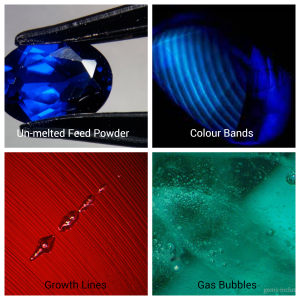How to Identify Synthetic Gemstones?
Gemstones are rare, Beauty, and durable minerals mined or Artificially made by humans. Gemstones are mainly divided into three main groups. They are,
- Natural Gemstones
- Synthetic Gemstones
- Artificial Gemstones
Natural Gemstones
Rare, Beauty and durable Minerals are formed naturally organically or inorganically and have an exact chemical composition, refractive index, specific gravity, optical properties, and crystal system.
Ex: Diamond, Sapphire, Spinel, Pearl Etc.
Synthetic Gemstones
Synthetic gemstones are gems made artificially by humans matching chemical composition, optical properties, and other natural properties of Natural gemstones. Refractive index, specific gravity, and optical & other properties are identical to Natural Gemstones. Synthetic gemstones can be differentiated by the Natural Inclusions inside the gems.
Ex: Synthetic Sapphire, Synthetic Spinel, Cubic Zirconia Etc.
Artificial Gemstones
Artificial gemstones are gems made by humans matching only the appearance of Natural gemstones. Artificial gemstones are made using cheap raw materials like Acrylic, Polycarbonate (PC), Polyethylene (PE), Polypropylene (PP), Polyethylene Terephthalate (PET), and Polyvinyl Chloride (PVC). Because of this the price and value of Artificial gemstones are very low. Artificial gemstones are manufactured on a large scale and traded on a large scale.
Ex: Blue Beads, Red Beads, Sequins Etc.
How Synthetic Gemstones are made?
Synthetic Gemstones are made by melting chemical components (Feed powder) in high temperatures and cooling down the melted liquid as crystals. There are a few methods of making synthetic gemstones here are,
- Flame fusion Method or Verneuil process
- Crystal pulling or the Czochralski method
- Zone melting method
- Skull melting method
- Hydrothermal method
- Flux-melt growth processes
The following Chemical Components are used to get the Colour in Synthetic gemstones.
Purple – Manganese (Mn), Nickel (Ni), Cobalt (Co)
Pink – Manganese (Mn), Nickel (Ni), Cobalt (Co)
Blue – Cobalt (Co), Titanium (Ti), Ferrous (Fe)
Blue-Green – Titanium (Ti), Ferrous (Fe), Chromium (Cr)
Green – Ferrous (Fe) & Chromium (Cr)
Yellow-Green – Chromium (Cr), Uranium (U)
Yellow – Manganese (Mn), Titanium (Ti), Ferrous (Fe), Sulfur (S)
Brown-Yellow – Sulfur (S), Uranium (U)
Brown – Ferrous (Fe), Nickel (Ni)
Red – Chromium (Cr), Ferric (Fe+3)
For example, Synthetic sapphires are made by mixing Aluminum oxide powder (Feed powder) with D-block coloring chemical elements like Chromium, Ferrous & Titanium, etc. Synthetic gemstones can be manufactured in a limited time (In a Few Hours), but natural gemstones take thousands of years to form under the earth. Since synthetic gemstones, it is really hard to include Natural Inclusions and Natural Surface features. This will be the key factor to identify synthetic gemstones.
How to Identify Synthetic Gemstones
Due to the limitations in manufacturing synthetic gems, gemologists can easily identify synthetic gemstones using a Microscope but how do gem traders and gem enthusiasts find synthetic gemstones in the Gem Market? In the following article, we will be examining the easiest way to identify synthetic gemstones using a Jewelers Loop and torch light.
- Identifying synthetic gemstones using a gem torch is a very easy task in many varieties of gemstones except for some single refractive gemstones. Synthetic gemstones when torched will be seen as the best color of the gem in every opposite direction and vice-versa.
- Identifying synthetic gemstones by seeing the Surface features of gems. Checking Striations, Cleavages, Etch marks, and Negative crystal cavities in the surface of Gemstones. Normally these surface features cannot be seen in Synthetic gemstones.
- Identifying synthetic gemstones using a jeweler’s loupe. This is the best observation to identify synthetic gemstones is using a 10X loupe. When using jewelers loupe correctly we can examine the following inclusions in synthetic gemstones.
- Gas bubbles in shapes of Torpedo, Tadpole, Flask-like, Round, and Oval, as single gas bubbles, clusters, and gas bubbles in irregular nature.
- Fine curved growth lines (Striae) in certain directions in synthetic gemstones.
- Curved color bands can be observed in synthetic gemstones.
- In synthetic gemstones, unmelted feed powder can be observed.
Conclusion
The synthetic gemstone industry is a multi-million market to cater world-class brands to manufacture their amazing products. The main purpose of manufacturing synthetic gemstones is to get unique colored and planed-sized gemstones without any inclusions and fractures, but some scammers try to trade synthetic gemstones pretending natural gems. This activity is unethical and not professional business practice done by scammers. This normally happens in gem markets of Madagascar, Tanzania, Mozambique, Sri Lanka, Afghanistan, Vietnam, China, Indonesia, etc. When you learn how to identify synthetic gemstones the tendency to get caught in a scam will reduce in these gemstone markets all over the world.
Synthetic gemstones can easily identify in a Gemological Laboratory when observed through a Microscope. When Natural gemstones are observed through a microscope we can examine feathers, fingerprints, crystals, crystal cavities, and many more natural inclusions. In this article, we planned to prepare everyone to identify synthetic gemstones in the gem market with limited gemological instruments (Torch and Loupe) to avoid scams and scammers in gemstone markets all over the world.
There are a lot more methods Gem experts use in markets to identify synthetic gemstones (checking the heft) but we have mentioned in the above article the easiest way with limited instruments. Even a beginner can figure out synthetic gemstones using the above methods to avoid fraud. The main methods to observe synthetic gemstones are:
- Identifying synthetic gemstones using a gem torch.
- Identifying synthetic gemstones by seeing the Surface features of gems.
- Identifying synthetic gemstones using a jeweler’s loupe. (Observing Inclusions)
Reference
Gemological Institute of America
Gem and Jewellery Research and Training Institute
Read More:
Wanna Learn What Gemstones are found in Sri Lanka – Read it Here













